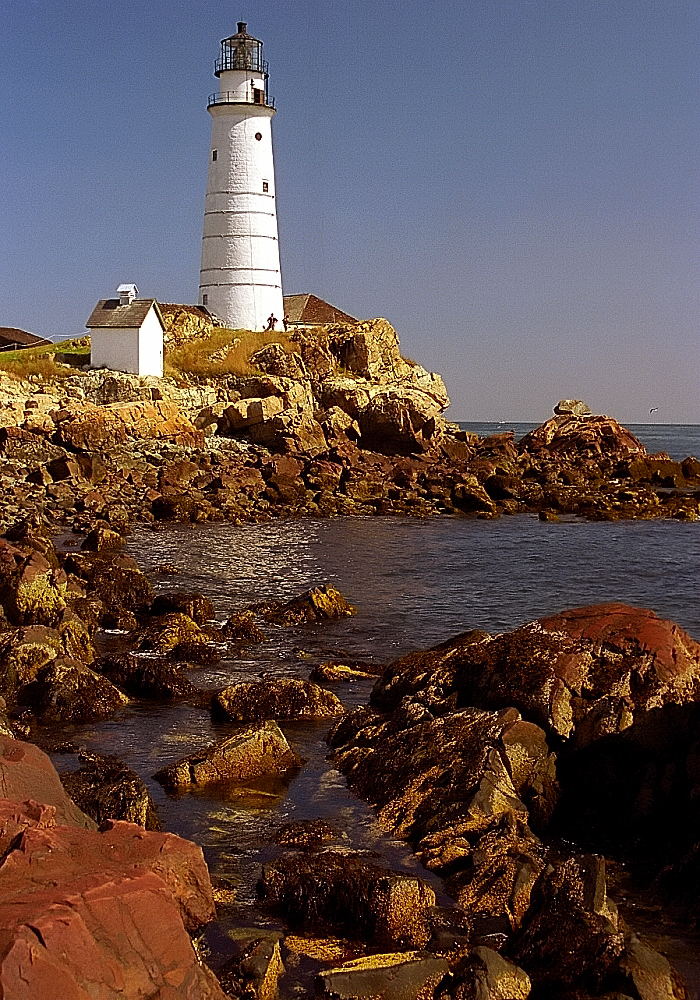
After visiting some of America’s northernmost New England lighthouses in our first post, we will tack a bit southerly into the “southern half” of the region. With lighthouses abounding throughout these states, we’ll have to be even more selective of where to visit (since we only have limited space available), but you can easily sail into broader explorations of these coastal icons.
NEW YORK
New York has the distinction of having lighthouses on six major bodies of water: Lake Erie, Lake Ontario, the Saint Lawrence River, Lake Champlain, the Hudson River, and the boundary waters into the Atlantic Ocean. While we can’t stop at all of them on this abbreviated virtual tour, you certainly can stop at many (for 3-5 minutes at a time) thanks to the WPBS Short Flix channel on YouTube. Through their work, you can join the crew at twenty lighthouses throughout the state. We’ll highlight three of the state’s towers below.
“Little Red Lighthouse,” Manhattan
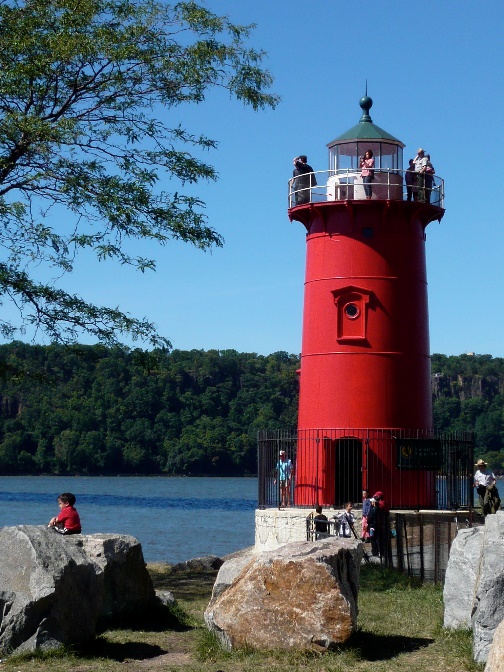
“The Little Red Light House” by shinya is licensed under CC BY 2.0
Most beloved by this title, the light is officially called the Jeffrey’s Hook Light. Located in Fort Washington Park and overlooking the Hudson River underneath the George Washington Bridge, the light has been partially popularized by a children’s book, The Little Red Lighthouse and the Great Gray Bridge. Join an official tour during the Little Red Lighthouse Festival in October 2019. As the only lighthouse in Manhattan since the 1940’s, the tower is only open once per year. (If you’re claustrophobic, thankfully the hike up the stairs is short, and you can skip ahead to the views from the top.) For more open views, check out a view of The High Line in Manhattan, a public park complete with open spaces and art displays. For some animal encounters, take in a video recently recorded at the Central Park Zoo.
Montauk Point Light, Montauk/East Hampton
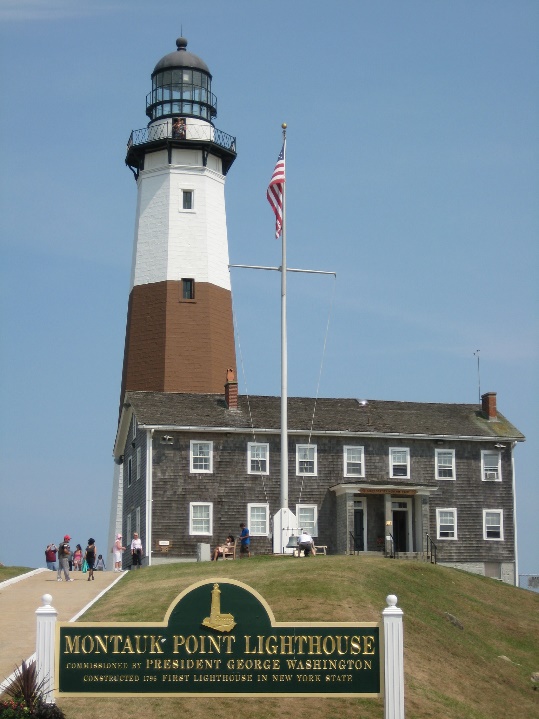
“Montauk Lighthouse, NY” by Cyberlemur is licensed under CC BY 2.0
We next trek over to Montauk Point State Park, adjacent to Camp Hero State Park on Long Island, to see this impressive site. Built at a critical maritime juncture, Montauk Light was the first lighthouse built in the state of New York. The house and tower we see today are the result of construction in 1860, which elevated the light, constructed the lightkeeper’s house, and connected the two. Thanks in part to its 110-foot height, the beacon can be seen nearly 19 miles distant. Substantial erosion prevention measures have allowed the facilities to stay at their current location. Join an up-close tour of the fourth-oldest active lighthouse in the United States, or take a flying tour from the comfort of your own seat.
Rock Island Light, Clayton
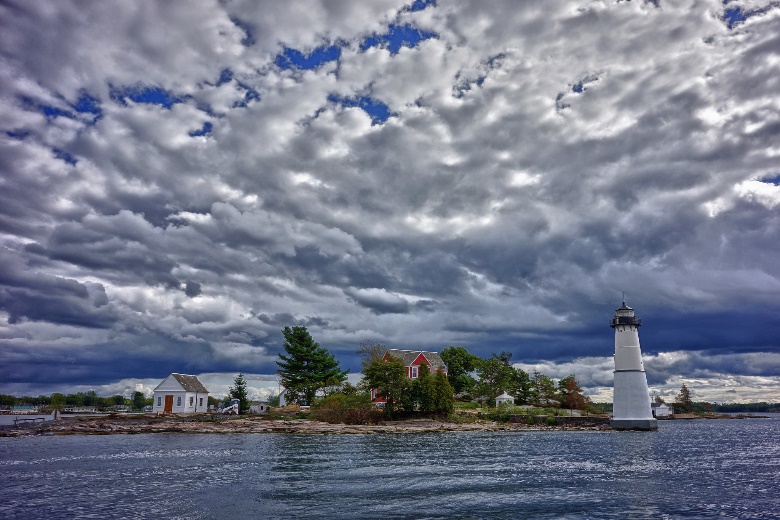
“Rock Island Lighthouse Clayton NY” by Ted Van Pelt is licensed under CC BY 2.0
We now head upstate to Rock Island Lighthouse State Park, set squarely in the Thousand Islands region of the Saint Lawrence River, downstream from Lake Ontario. As one of three lights on Rock Island, this location’s house and tower are fully open to take a tour, but to access the island you have to ride a boat. Originally built in 1848, the light was changed several times before being moved to its current offshore brick base in 1903. While you’re in the area, and you were on a boat ride and probably had boats on your mind, drop in (virtually) at the Antique Boat Museum, which offers four unique gallery tours on their website. More is available on their YouTube channel, The Wooden Boat Experience. For more sightseeing opportunities, meander throughout Long Island on a short aerial tour (because it took too long for a vehicle-based tour due to NYC traffic.)
To see some of this year’s ever-changing natural canvas on the landscape, check out some images via webcams at Niagara Falls (or just-across-the-border Horseshoe Falls with Goat Island), Whiteface Mountain (near Wilmington), Camp of the Woods (Speculator), Lake George, and Blue Mountain Lake.
MASSACHUSETTS
Boston Light, Boston
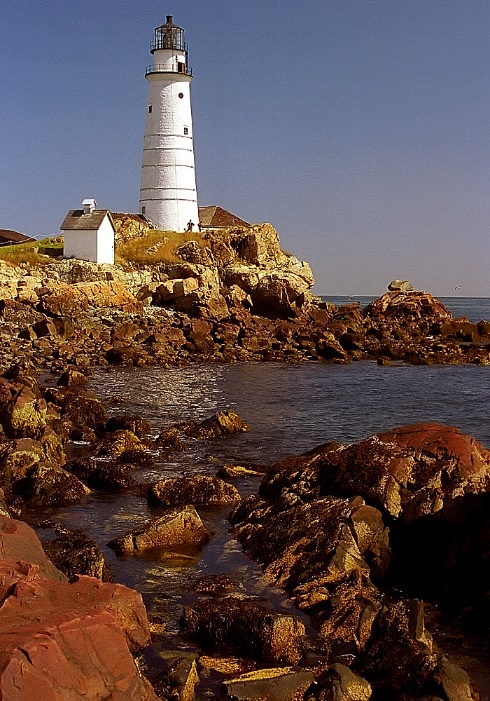
“Boston Light – Little Brewster Island” by David Paul Ohmer is licensed under CC BY 2.0
On the rocky Little Brewster Island in the outer Boston Harbor, this destination holds the distinction of being America’s first lighthouse. Originally built in 1716, it was destroyed by withdrawing British forces in 1776 during America’s war for independence. The 75-foot-high tower was rebuilt in 1783 before being raised to its current height of 98 feet that is visible for 30 miles to seaward. Recently renovated, the site reopened in 2015 and is available for tours. Visit the National Park website for a more detailed history of the only permanently staffed lighthouse in the country. Or join a narrated historical tour before delving into a tour of areas beyond Boston into the villages and towns on Cape Cod. For a one-of-a-kind musical immersion, enjoy a behind-the-scenes tour of the fully restored 12,000-pipe E.M. Skinner Organ at the Church of the Transfiguration.
Sankaty Head Light, Siasconset

“2008 06 08 – 2508-2511 – Siasconset – Sankaty Head Light” by thisisbossi is licensed under CC BY-SA 2.0
This memorable lighthouse first went into service in 1850 on the eastern tip of Nantucket Island, located south of Cape Cod. As one of the first of America’s lighthouses that received a revolutionary Fresnel lens, its light beaming well into the Atlantic. The ‘Sconset Trust took ownership of the light in 2007, and later that year had the brick-and-granite structure moved to a new location 250 feet away from the eroding bluff. Watch a televised documentary on how they moved this 500-ton beast – in one piece. Then visit the Trust’s website for some information about the light, and to take a tour to the top of the tower. And be sure to enjoy a flyby tour of the light at its new site.
With lighthouses seemingly surrounding the state’s coast, taking in a full lighthouse tour of the 15 lights around Cape Cod. Then check out this year’s Fall Foliage Guide for Massachusetts before doing some geographic leapfrog to see some foliage changes in Vineyard Haven, TV channel WWLP in western Mass. (psst! – you can even switch views between cities), and a cluster of sites in western Massachusetts.
RHODE ISLAND
Beavertail Lighthouse, Jamestown
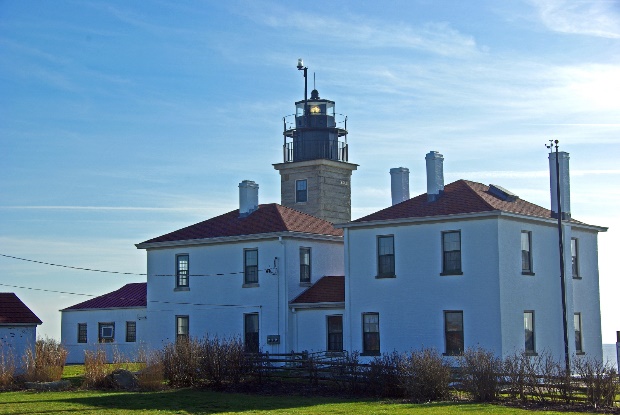
“Beavertail Light 2” by foroyar22 is licensed under CC BY-NC-SA 2.0
The Beavertail has sometimes been called the Newport Light, and the “premier” lighthouse of Rhode Island at the entrance to Narragansett Bay. A “beacon” existed in the area in 1712, with a wooden tower constructed in 1749 as the third lighthouse in the American colonies. The stone lighthouse was destroyed by the British in 1779 and the current 64-foot tower of granite was built in its place in 1856. Restored in 1989, it is now overseen by a local museum association next to Beavertail State Park. Watch an interview with one of the Association member describing the importance of the light and area operations during World War Two, then do a coastal flyover.
Block Island Southeast Light, New Shoreham
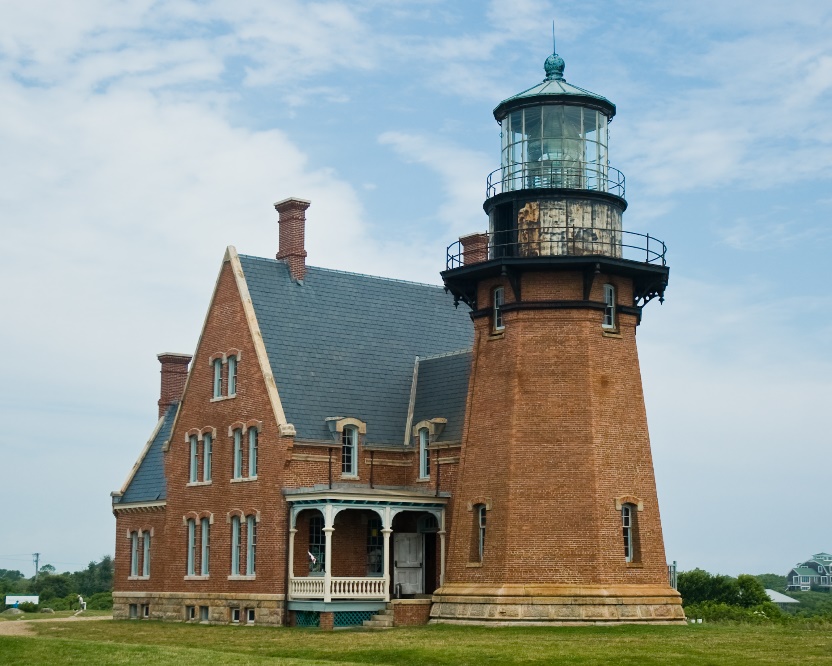
“Block Island Southeast Lighthouse” by hlkljgk is licensed under CC BY-SA 2.0
Constructed on the Mohegan Bluffs, this unique structure’s light went into service in February 1875. As an excellent yet rare lighthouse example of Gothic Revival architecture, the keeper’s house was designed for multiple staff to reside there simultaneously. In 1990 the light was replaced by an automated beam on a steel tower nearby, and the 2,000-ton house and light tower were moved inland due to the ongoing erosion threat to the bluff. The Southeast Lighthouse Foundation now owns and maintains the combined structure. Enjoy a 28-minute video on the Foundation’s website of how the lighthouse was moved in August 1993, then join a quick walk-through, including climbing the tower.
For nearby virtual sightseeing stops, take a leisurely drive down the length of historic and scenic (and often opulent) Ocean Drive in Newport. (I can attest this is a must-do experience if you’re anywhere near the area!) Peruse a fall foliage guide for Rhode Island before heading over to check on the scenic view at Waterman Lake in Smithfield.
CONNECTICUT
Mystic Seaport Light, Mystic
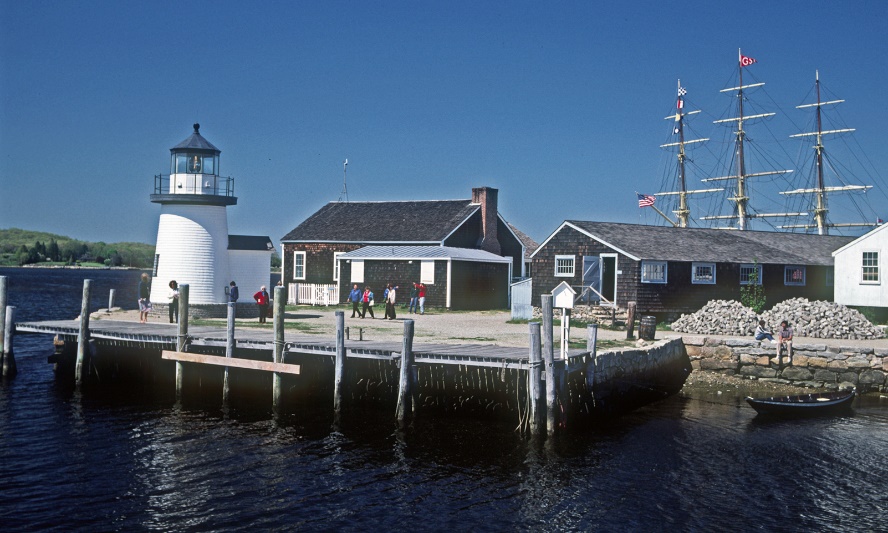
“Mystic Seaport Lighthouse, Mystic CT (May 1981)” by foroyar22 is licensed under CC BY-NC-SA 2.0
Though rather diminutive compared to many other lighthouses in the region, we want to make a stop at this cute, quaint location upstream from Noank. Only two stories tall, it was completed in 1967 as a replica of the Brant Point Light on Nantucket Island off Cape Cod. Though its light is not a navigational aid, the structure serves as a small museum focusing on the history and diversity of American lighthouses. Even with these highlighting physical features, the Mystic Seaport Museum has substantial online exhibits dedicated to 19th Century maritime history, including lighthouses, that is worth exploring. (The light and the masts of the restored whaling ship, the Charles W. Morgan, are both visible above.) Take a tour of the grounds and vessels, and be sure to check out the other educational videos on the museum’s YouTube channel for a host of other maritime and local interest videos.
New London Harbor Light, New London
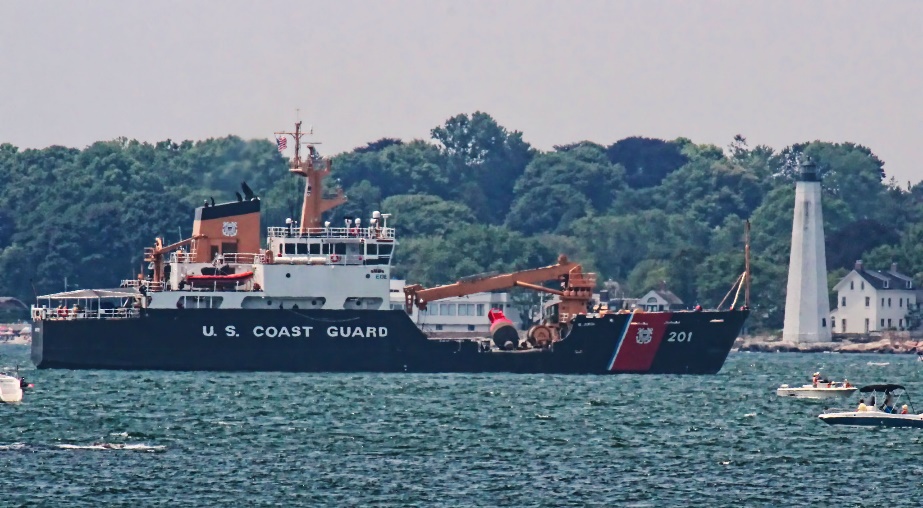
“USCGC JUNIPER (WLB-201) passing New London Harbor Light, OpSailCT 2012” by Jay Mac 3 is licensed under CC BY-NC-ND 2.0
At 89 feet, the oldest and tallest lighthouse in Connecticut deserves to be on our virtual tour, having also been elevated to wider recognition on a Forever stamp by the U.S. Postal Service. Constructed in 1801 at Lighthouse Point in New London, it originally held eleven lamps, which were replaced with a Fresnel lens in 1855, then upgraded again by electrification in 1930. Several other buildings had existed on the property, but these have been removed in days gone by. The New London Maritime Society now owns and maintains the buildings and property. Join a local lighthouse cruise to see seven local lighthouses, and enjoy an interview with the Society’s director about all of the lighthouses in the area. Just a hop, skip and jump away is the opportunity to tour the U.S. Navy’s Submarine Force Library and Museum, which includes the first nuclear-powered vessel, the USS Nautilus and is dedicated to the equipment and people who built and/or served aboard U.S. submarines.
For foliage views, check in on the webcams at Mohawk Mountain (in the northwest corner of the state at the town of Cornwall), Central Village, and several weather cameras from around Connecticut.
Lighthouses and leaves, an inseparable pair of immense attraction between humans, architecture and nature. In this and coming weeks, I hope you will be able to enjoy a small sampling of both as Fall creeps gradually nearer to Central PA. Be on the lookout for a new Armchair Traveler adventure destination next week!
Recommended Reading
The Library has numerous items available about the history, people, and stories of these three states, either in fiction or in real life. Some e-resources are also available to borrow and enjoy.
Revolution on the Hudson: New York City and the Hudson River Valley in the American War of Independence, by George C. Daughan
Early in the war, the Hudson River was the focal point of much of Britain’s military effort to crush the upstart American cause. With New York City as a base of operations, it drew equal levels of attention from American leaders and civilians alike, including George Washington. Politics, personalities, and plucky planning combine in the British plan that could have worked. Yet the author argues to the contrary. Intricate military plans, topped with shifting yet complex colonial politics on both sides of the Atlantic, give rise to a fascinating learning opportunity, and hopefully help resolve the ongoing question of how the colonists defeated the dreadnaught forces under the Union Jack.
The Beetlebung Farm Cookbook: A Year of Cooking on Martha’s Vineyard, by Chris Fischer
With a year of wholly American cooking, thanks to a five-acre plot of land on the island for sustainable food sourcing through farming, the book is an inspiration to chefs of all levels to better connect with the lands around them. A practical cookbook, it’s worth a read to inspire a more knowledgeable and fresh-food-connected cook, with creatively different recipes along the way.
The Finest Hours: The True Story of the U.S. Coast Guard’s Most Daring Sea Rescue, by Michael J. Touglas and Casey Sherman
During a midwinter storm in February 1952, Cape Cod witnessed the destruction of two oil tankers torn apart by the storm-ravaged seas. Despite the seemingly insurmountable risks, Coast Guardsmen braved the wind and waves to attempt to save over thirty sailors on the two wrecks. This is the story of their success … or failure.
Final Voyage: A Story of Arctic Disaster and One Fateful Whaling Season, by Peter Nichols
The community of New Bedford has long been a ship-builder’s home, along with the historic whaling fleet of yesteryear. In 1871, a fleet of ships left the harbor – but never returned. Discover the town’s origins in Quaker traditions, development of the coast based on easy access to the sea, along with the economic gains alongside increasingly tenuous risks, of the whaling and shipping community.
The House of the Seven Gables, by Nathaniel Hawthorne
In Hawthorne’s classic work of Gothic Romance, a sizable yet downtrodden house is fabled to be haunted by a curse on the last members of Salem’s Pyncheon family. Generational greed and enduring elitism has turned the four survivors into impoverished isolationists. Yet they are not the only sources of evidence for the massive familial and architectural downturn, with hidden documents tucked mysteriously away into the house itself. Will the family members stay alive long enough to discover secrets of the past and live to see the family name reinvigorated – or dashed to pieces forever by the papers’ contents?
This program supported by




